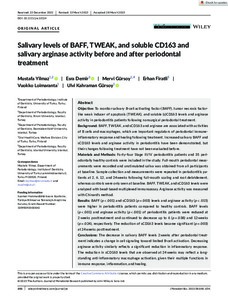Salivary levels of BAFF, TWEAK, and soluble CD163 and salivary arginase activity before and after periodontal treatment
Firatli Erhan; Demir Esra; Yilmaz Mustafa; Gürsoy Ulvi Kahraman; Gürsoy Mervi; Loimaranta Vuokko
https://urn.fi/URN:NBN:fi-fe2023051744745
Tiivistelmä
Objective: To monitor salivary B-cell activating factor (BAFF), tumor necrosis factor-like weak inducer of apoptosis (TWEAK), and soluble (s)CD163 levels and arginase activity in periodontitis patients following nonsurgical periodontal treatment.
Background: BAFF, TWEAK, and sCD163 and arginase are associated with activities of B cells and macrophages, which are important regulators of periodontal immune-inflammatory response and healing following treatment. Increased salivary BAFF and sCD163 levels and arginase activity in periodontitis have been demonstrated, but their changes following treatment have not been evaluated before.
Materials and methods: Forty-four Stage III/IV periodontitis patients and 35 periodontally healthy controls were included in the study. Full-mouth periodontal measurements were recorded and unstimulated saliva was obtained from all participants at baseline. Sample collection and measurements were repeated in periodontitis patients at 2, 6, 12, and 24 weeks following full-mouth scaling and root debridement, whereas controls were only seen at baseline. BAFF, TWEAK, and sCD163 levels were analyzed with bead-based multiplexed immunoassay. Arginase activity was measured with Chinard's method.
Results: BAFF (p < .001) and sCD163 (p = .003) levels and arginase activity (p < .015) were higher in periodontitis patients compared to healthy controls. BAFF levels (p < .001) and arginase activity (p < .001) of periodontitis patients were reduced at 2 weeks posttreatment and continued to decrease up to 6 (p = .038) and 12 weeks (p = .024), respectively. The reduction of sCD163 levels became significant (p = .003) at 24 weeks posttreatment.
Conclusions: The decrease in salivary BAFF levels 2 weeks after periodontal treatment indicates a change in cell signaling toward limited B-cell activation. Decreasing arginase activity similarly reflects a significant reduction in inflammatory response. The reduction in sCD163 levels that are observed at 24 weeks may reflect a longstanding anti-inflammatory macrophage activation, given their multiple functions in immune response, inflammation, and healing.
Kokoelmat
- Rinnakkaistallenteet [19207]
